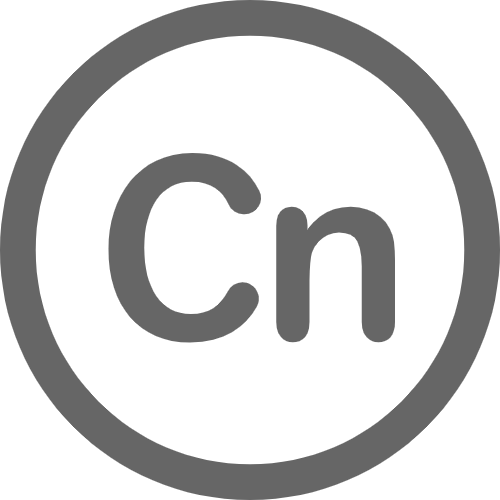Xiaoyan Wang Lab
Our long term goal is to explore the pathogenesis of dental caries and apical periodontitis, and to develop biomaterials and digital technologies for prevention and treatment.
Our team's research initially focuses on the pathogenesis of dental caries, apical periodontitis. By employing techniques such as biochemistry, molecular biology, super-resolution fluorescence imaging, single-molecule tracking, and X-ray diffraction crystallography, the team investigates the division and regulatory mechanisms of oral microorganisms, including Streptococcus mutans, and explores potential drug targets within these mechanisms.
Another research direction is the development of novel biomaterials for prevention and therapy of dental disease and tissue regeneration, with the aim of reducing the incidence of dental caries and the occurrence of apical periodontitis following root canal treatment (RCT).
We also interested in the explore the molecular mechanism of external root resorption.
DIRECTOR
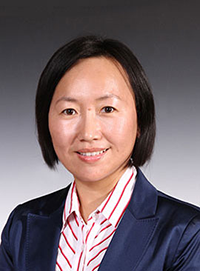
Xiaoyan Wang, DDS, PhD
Professor, Chief Physician
Principal Investigator
wangxiaoyan@pkuss.bjmu.edu.cn
Professor Xiaoyan Wang is dean of Department of Cariology and Endodontology, Peking University School and Hospital of Stomatology. She concurrently serves as the Chairperson of the Endodontics Professional Committee of Beijing Stomatological Association, the Deputy Chairperson of the Oral Laser Professional Committee of Beijing Stomatological Association, and the Deputy Chairperson of the Digital Stomatology Industry Branch of the National Health Industry Enterprise Management Association.
As a principal investigator, Pro. Wang has long been engaged in research work on the diagnosis and treatment of endodontic diseases, and has a solid research foundation especially in aspects such as constructing methods for controlling root canal infections and repairing periapical bone lesions. In recent years, Pro. Wang has undertaken the Appropriate Technology Promotion Project of the National Center for Stomatology, namely "Appropriate Technology for the Control of Complex Root Canal Infections", and National Natural Science Foundation of China projects including "Preparation of Injectable Composite Hydrogels with Gradient Structure and Research on Their Regulation of Angiogenesis and Osteogenesis Behaviors", "Research on the Mechanism of Action of Injectable VEGF-Intelligently Modified Microporous Double-Network Hydrogels in Bone Repair", and "Composite System of Polymer Antibacterial Agents for Dental Use with Programmable Controlled Release". She has also carried out projects such as the Beijing Science and Technology Plan project "New Resin-Based Oral Restoration Materials" and the Beijing Natural Science Foundation project "Study on the Acid Resistance Mechanism of the Cell Division Protein FtsZ of Streptococcus mutans". Additionally, Pro. Wang has participated in major projects of the National Natural Science Foundation such as "Mechanism of Oral Microecology and Maintenance and Remodeling of Periodontal Homeostasis".
RESEARCH AREAS
Oral Biomaterial
Untreated dental caries of permanent teeth and severe periodontitis were the most common oral conditions. Developing a novel material that can simultaneously control both diseases would be a beneficial endeavor. Our lab is focus on the functional integration of dentin remineralization, matrix metalloproteinases inhibition, anti-inflammation, and periodontal regeneration.
We have synthesized biocompatible strawberry-shaped hemispheric Janus particles (Catechol-silica-NR3+ JPs) for the rapid and stable occlusion of dentin tubules. The JPs provided a novel approach to the treatment of dentin hypersensitivity. As respect of biomaterials with adjustable properties in tissue repair, we construct an injectable double-network (DN) hydrogel with varying stiffness. We find that selecting appropriate substrate stiffness or gradient stiffness hydrogel could align with the optimal mechanical environment required for specific cell growth and function. We also work on leveraging polymer physical-chemical methodologies to enhance the performance of root canal filling materials, particularly optimizing their sealing properties to improve the quality and efficacy of root canal treatments.
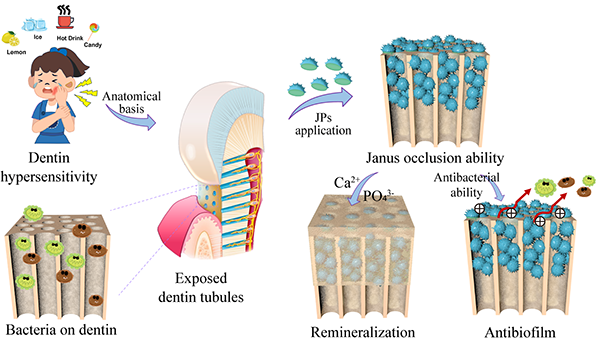
Anatomical basis of dentin hypersensitivity, and adhesion, occlusion, remineralization, anti-biofilm capacity using the hemispherical Catechol-silica-NR3+ JPs.
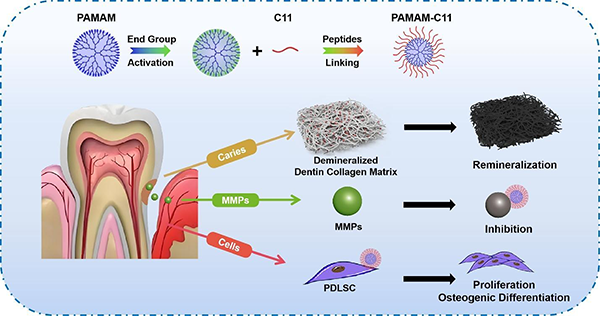
Diagram of Amelogenin-derived peptide (C11) -modified poly(amidoamine) dendrimers (PAMAM).

Thermal conduction mechanisms showing as "three-stage bridging model"
Oral microbe
Streptococcus mutans is the primary pathogen responsible for the occurrence of dental caries. Using in vitro biochemical techniques, we have discovered the high tolerance of the cytoskeletal protein FtsZ in Streptococcus mutans to acidic environments. Furthermore, by employing X-ray diffraction crystallography, we have determined the crystal structure of FtsZ in Streptococcus mutans and elucidated the underlying tolerance mechanisms.
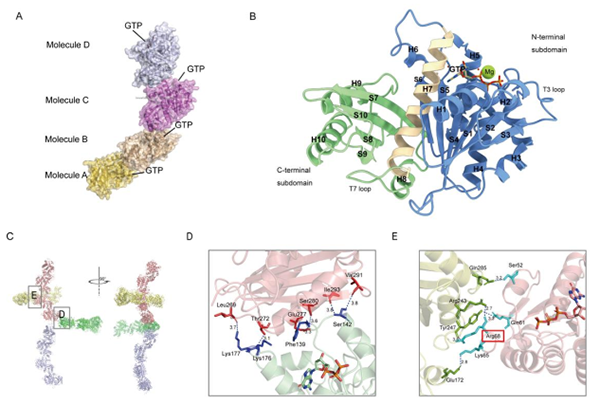
Structure of SmFtsZ tetramers
External root resorption
The dysregulation of MMPs is related to (ERR), one of the most severe complications, along with substantial loss of dental tissue, induced by trauma, pulpal infection, tooth bleaching, and orthodontic treatment. We find that DDR1 is a potent regulator of MMP-1, MMP-2, and MMP-13 expression through the Smad2/3, MEK-ERK1/2, and PI3K/Akt signaling pathways. Clarifying the significance and underlying mechanism by which DDR1 is involved in ERR might bring the chances to hinder the pathogenic process of ERR, hence reducing its incidence rate.

Effects of DDR1 knockdown on MMP-2 via the Smad2/3 signaling pathway and MMP-13 via the MEK-ERK1/2 and PI3K/Akt signaling path
RECENT PUBLICATIONS
Biomimetic Janus particles induced in situ interfacial remineralization for dentin hypersensitivity
Advanced Functional Materials, Jan 2025
Amelogenin-Derived Peptide-Modified Poly(amidoamine) Dendrimers for Root Caries Prevention
ACS applied materials & interfaces, Jan 2025
Gelatin methacryloyl-phenylboronic acid/Hydroxyadamantane self-healing microgels for the periodontitis treatment by promoting alveolar bone regeneration
International Journal of Biological Macromolecules, Apr 2025
Injectable double network hydrogel with adjustable stiffness for modulation of macrophage polarization
Polymer Testing, Feb 2025
Chemokine receptor-2 deficiency induced mild experimental periapical lesion in mice
Journal of Dental Sciences, Jan 2025
Role of DDR1 in Regulating MMPs in External Root Resorption
International Journal of Molecular Sciences, Nov 2024
Clinical evaluation of Giomer and self-etch adhesive compared with nanofilled resin composite and etch-and-rinse adhesive - Results at 8 years
Dental Materials, Jul 2024
Injectable EC-BMSC hydrogel with prolonged VEGF action for enhanced angiogenesis
Polymer Testing, Aug 2023
Injectable double-network hydrogel-based three-dimensional cell culture systems for regenerating dental pulp
ACS applied materials & interfaces, Feb 2023
Influence of relative positions of the heat carrier and lateral canal opening on gutta-percha obturation of lateral canals in a three-dimensional-printed model
Journal of Dental Sciences, Feb 2023
Effect of 3-dimensional collagen fibrous scaffolds with different pore sizes on pulp regeneration
Journal of Endodontics, Oct 2022
Chlorhexidine-loaded poly (amido amine) dendrimer and a dental adhesive containing amorphous calcium phosphate nanofillers for enhancing bonding durability
Dental Materials, Apr 2022
Effectiveness of different cleaning measures on the bonding of resin cement to saliva- contaminated or blood-contaminated zirconia
Journal of Dentistry, May 2022
Effectiveness of different cleaning measures on the bonding of resin cement to saliva-contaminated or blood-contaminated zirconia
Journal of Endodontics, Mar 2022
Effects of DDR1 on migration and adhesion of periodontal ligament cells and the underlying mechanism
Journal of periodontal research, Feb 2022
Streptococcus mutans cell division protein FtsZ has higher GTPase and polymerization activities in acidic environment
Molecular Oral Microbiology, Feb 2022
KMT2D deficiency disturbs the proliferation and cell cycle activity of dental epithelial cell line (LS8) partially via Wnt signaling
Bioscience reports, Nov 2021
Surface roughness and gloss of polished nanofilled and nanohybrid resin composites
Journal of Dental Sciences, Oct 2021
Three-dimensional morphologic classifications and analysis of canal isthmuses in permanent molars
Surgical and Radiologic Anatomy, Jul 2021
Efficiency and temperature rise of file ablation by Neodymium: Yttrium-Aluminum- Perovskite Laser in vitro
Journal of Endodontics, Jun 2021
TEAM

Bing Han
Co-PI
hanbing822@126.com
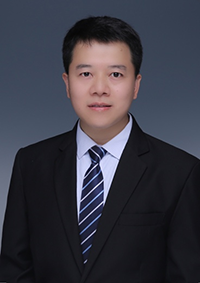
Jie Nie
Co-PI
niejiepkuss@126.com
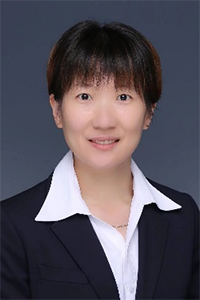
Chongyang Yuan
Co-PI
yuanyin21@126.com

Xue Cai
Co-PI
caix2010@qq.com

Lu Zhang
Co-PI
pku_zhanglu@126.com
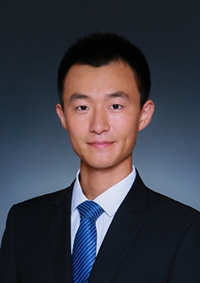
Peng Yu
Co-PI
yupeng@bjmu.edu.cn

Yongliang Li
Co-PI
1211210520@bjmu.edu.cn
CONTACT
Xiaoyan Wang
wangxiaoyan@pkuss.bjmu.edu.cn
Peking University School and Hospital of Stomatology,
No.22 Zhongguancun South Avenue,
Haidian District, Beijing 100081, PR China
last text: Department of Oral Medicine
next text: Weiran Li Lab



